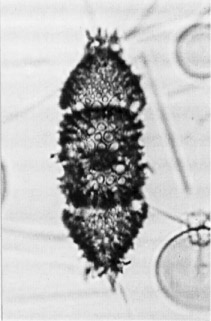 Didymocyrtis
tetrathalamus tetrathalamus (Haeckel)
Didymocyrtis
tetrathalamus tetrathalamus (Haeckel) Didymocyrtis
tetrathalamus tetrathalamus (Haeckel)
Didymocyrtis
tetrathalamus tetrathalamus (Haeckel)Panartus tetrathalamus Haeckel, 1887, p.378, pl.40, fig.3; Nigrini, 1967, p.30, pl.2, figs.4a-4d (with synonymy)
Panartus tetrathalamus tetrathalamus Haeckel, Nigrini, 1970, p.168, pl.1, fig.12
Didymocyrtis tetrathalamus (Haeckel), Sanfilippo and Riedel, 1980, p.1010
Terminology is that proposed by Riedel (1957, p.76). Cortical twin-shell constricted equatorially, with subcircular to subangular pores, having no definite arrangement, sometimes hexagonally framed; surface usually rough, spiny. Polar caps, when present, hemispherical to conical, approximately the same breadth as cortical twin-shell, supported by about 12 spines. Caps generally more delicate than twin-shell, with smaller pores and smoother surface. There are approximately equal numbers of specimens with and without single polar caps; rarely, completely or incipiently double-capped specimens are found. A few specimens have a delicate lateral meshwork supported by numerous rods, usually around the twin-shell, but sometimes extending around the caps. There is a tendency for middle-latitude forms to develop rather stout unbranched spines, either on the distal ends of the cortical twin-shell or on the polar caps. Such forms are rare in low latitudes.
Outer medullary shell lenticular, inner one spherical; radial beams connect outer medullary to twin-shell at the equatorial constriction (Nigrini, 1967).
Length of cortical twin-shell 90-136 µm; of polar caps 36-63 µm. Maximum breadth of cortical twin-shell 72-109 µm (Nigrini, 1967).
D. tetrathalamus differs from D. avita in the absence of tubercles on the cortical shell.
This species has a non-tuberculate, equatorially constricted cortical shell with two large polar caps. It varies in that the surface of the cortical shell may be very smooth, or quite spiny, even to the extent that broad based spines may give the appearance of a tuberculate surface. Polar caps may be absent, small, well developed and sometimes double. They are frequently supported well away from the cortica1 shell by about twelve spines creating a row of large arches between cap and shell. In other specimens caps are attached closely, the pores between the cap and the cortical shell being about the same size as those of the latter. The shell in some specimens is surrounded by a veil, which may enclose the cortical shell only or cortical shell and caps (Sanfilippo et al., 1985).
D. tetrathalamus is found in assemblages of late Pliocene to Quaternary age from latitudes lower than 40°. Its evolutionary transition from Didymocyrtis avita lies within the Spongaster pentas Zone. It is extant.
D. tetrathalamus is the extant representative of the Didymocyrtis lineage, having evolved from D. avita.
Additional illustrations can be found in Riedel and Sanfilippo, 1971, pl.1C, figs.5-7.
The nominate subspecies permits distinction from D. tetrathalamus coronatus (Haeckel) in Nigrini, 1970, p.168, pl.1, figs.13-14 (as Panartus tetrathalamus coronatus).